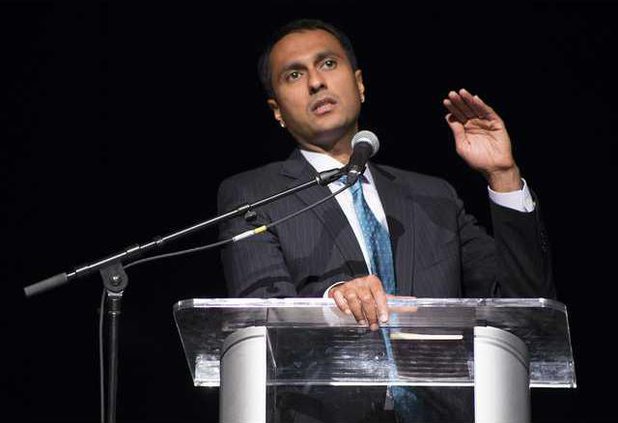In a crowded university auditorium, a young woman leaned over to her neighbor and asked, "Have you heard of this guy before?"
The pair, along with dozens of their fellow college students, had heard of the event from friends and professors, but the speaker, Eboo Patel, was unfamiliar.
Patel, founder and president of Interfaith Youth Core and the University of Utah's event's guest of honor, would likely view the girl's question as a good metaphor for interfaith work.
"Most of the students (at our events) are there because of a professor, a chaplain, a diversity officer or a friend from their dorm," Patel said. "It's our job to capture their imagination."
By encouraging students who have more questions than answers to become involved in service projects and conversations across difference, the interfaith movement has caught the attention of a generation known for its disenchantment with religion. Regardless of how students are introduced to interfaith initiatives, Patel and other faith leaders say that young adults become engaged because the events empower them to be better communicators and leaders.
"Interfaith work creates colleagues, staff members and citizens who are more able or willing to understand why or how someone else is doing something," said Jillian Yoder, assistant chaplain at The College of Wooster in Ohio. "Students learn to be good communicators, and I think the world needs that."
The power of young people
In speaking to students, Patel uses popular figures like Mahatma Gandhi and Martin Luther King Jr. to help listeners draw inspiration from others in spite of faith differences. Patel recently told a radio audience that Gandhi and King are valuable reference points not only because of how well-known they are, but also because of how young they were when they began their peace efforts.
"So many of the people that we collectively admire most were young when they began their movement, including their interfaith movements," he said. "(IFYC) believes that young people can be the people who make religion a bridge of cooperation just as they have over history."
College students are the focus of IFYC's work. By harnessing the power of youth, Patel explained, the organization creates communities where interfaith cooperation facilitates "common action for the common good" rather than conflict.
But is the power of youth still potent in a 21st century world where young people are often cited for their rejection of religious traditions?
In a comprehensive study of American millennials in 2010, Pew Research Center reported, "(Young adults) are less likely to be affiliated than their parents' and grandparents' generations were when they were young. Fully one-in-four members of the millennial generation … are unaffiliated with any particular faith."
For Yoder, the key to understanding why interfaith work remains relevant on campus in spite of declining religious involvement is understanding that students are still seekers and interested in exploring "big questions."
Rather than ask students to come prepared with answers, the College of Wooster's Office of Interfaith Campus Ministries only requires an open mind.
Yoder's favorite examples of interfaith involvement are the programs that allow students of all backgrounds to have conversations, which tackle difficult topics in informal settings. More formal events include weekly interfaith scholar lunches, meetings with religious mentors from the Wooster community and volunteering at local organizations.
Patel has a similar explanation for his organization's success. IFYC began with a $35,000 grant from the Ford Foundation and now operates with a $5 million budget. Each year, IFYC hosts several Interfaith Leadership Institutes for college students and faculty members, equipping them with resources to improve the interfaith dialogue on their campuses. In the fiscal year ending July 2014, 420 students participated.
Additionally, as a supporter of the President's Interfaith and Community Service Campus Challenge, IFYC is part of a network of more than 350 higher-ed institutions.
While interfaith initiatives 30 or 40 years ago were generally limited to representatives of major faiths like Christianity, Islam and Judaism, the modern movement invites students of all backgrounds, "from atheism to Zoroastrianism," Patel explained.
"The only litmus test for being involved in our work is good will," he said.
The focus of the work
During Thursday's speech at Utah State University, Patel acknowledged that people might assume that interfaith work pulls people away from their childhood faith by exposing them to other belief systems. But he asserted that it's actually meant to deepen students' relationship to their faith, not distance them from it.
Through interfaith involvement in community projects or social gatherings, Patel explained, students deepen their appreciation for other traditions. And they can also allow interactions with others to strengthen their understanding of their own tradition.
The goal of interfaith work is simple, Yoder said. Students are taught to be better listeners and encouraged to spend time thinking about their own beliefs.
"We want students to become critical thinkers," Yoder said. "We want them to be able to articulate their position but to also situate themselves within situations of dissonance and learn to be able to exist in that, to listen deeply to one another."
The movement centers on building a world where people of faith can take action together, making the world better by overcoming doctrinal differences.
"What can we do together?" Patel asked the audience. "It will not be everything, but it cannot be nothing."
That work, as Patel noted, begins with personal connections, with professors or friends who invite college students to step outside of their comfort zones to attend events and to overcome the apathy that's often associated with campus life.
"All that we're saying is that a college campus ought to be a place where people who orient around religion can engage each other positively and proactively on questions of ultimate concern," Patel said.
Email: kdallas@deseretnews.com Twitter: @kelsey_dallas





